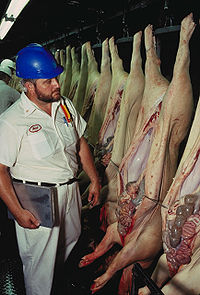Slaughterhouses (no poultry-)
Mechanically separated meat (MSM), a product also known as mechanically recovered/reclaimed meat (MRM), mechanically deboned meat (MDM), is a paste-like meat product produced by forcing beef, pork, turkey or chicken bones, with attached edible meat, under high pressure through a sieve or similar device to separate the bone from the edible meat tissue. For the production of chicken and turkey MSM, most of the time, breast carcasses are used as they still contain parts of breast meat.
Mechanically separated meat has been used in certain meat and meat products since the late 1960s. This product can be contrasted with meat extracted by advanced meat recovery systems. The most common use of MSM is into hot dogs
Slaughterhouses act as the starting point of the meat industry, where stock come from farms/market to enter the food chain. They have existed as long as there have been settlements too large for individuals to rear their own stock for personal consumption.
Early maps of London show numerous stockyards in the periphery of the city, where slaughter occurred in the open air. A term for such open-air slaughterhouse is a shambles. There are streets named "The Shambles" in some English towns (e.g. Worcester, York) which got their name from having been the site on which butchers killed and prepared animals for consumption


A steer restrained for stunning just prior to slaughter.
In the latter part of the 20th century, the layout and design of most US slaughterhouses has been significantly influenced by the work of Dr. Temple Grandin. It was her fascination with patterns and flow that first led her to redesign the layout of cattle holding pens.
While Grandin’s primary objective is to help slaughterhouse operators improve efficiency and profit, she suggested that reducing the stress and suffering of animals being led to slaughter may help achieve this aim. In particular she applied an intuitive understanding of animal psychology to design pens and corrals which funnel a herd of animals arriving at a slaughterhouse into a single file ready for slaughter. Her corrals employ long sweeping curves so that each animal is prevented from seeing what lies ahead and just concentrates on the hind quarters of the animal in front of it. This design also attempts to override the animals’ survival instincts and prevent them from reversing direction.
Grandin now claims to have designed over 54% of the slaughterhouses in the United States as well as many other slaughterhouses around the world .

Curved cattle corrals designed by
Temple Grandin are intended to reduce stress in animals being led to slaughter.
From Wikipedia, the free encyclopedia :
Slaughterhouses (no poultry-)






